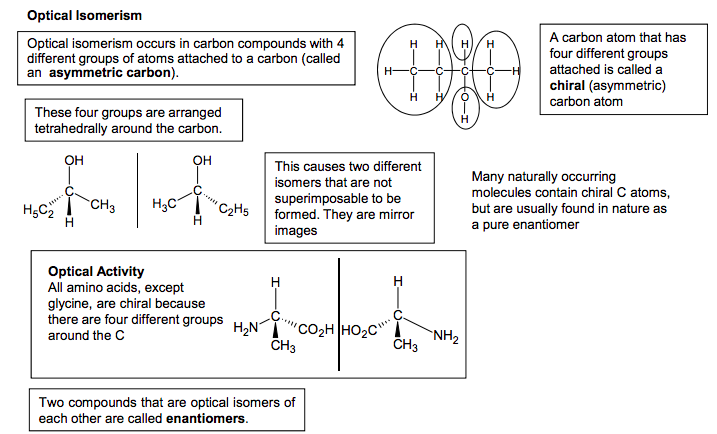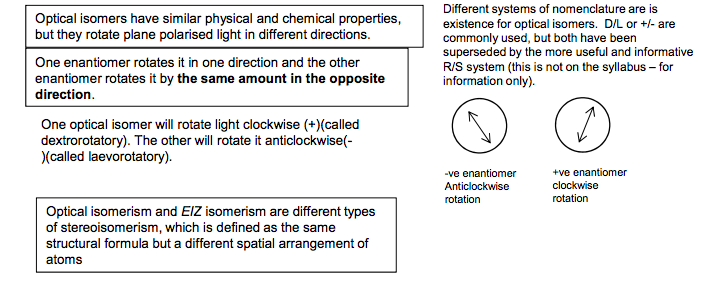

Optical Isomerism Optical isomerism occurs in carbon compounds with 4 different groups of atoms attached to a carbon (called an asymmetric carbon). C H C H C H H H C H H H O H H A carbon atom that has four different groups attached is called a chiral (asymmetric) carbon atom These four groups are arranged tetrahedrally around the carbon. C H5C2 CH3 H OH C C2H5 H3C H OH This causes two different isomers that are not superimposable to be formed. They are mirror images Two compounds that are optical isomers of each other are called enantiomers. Many naturally occurring molecules contain chiral C atoms, but are usually found in nature as a pure enantiomer Optical isomers have similar physical and chemical properties, but they rotate plane polarised light in different directions. One enantiomer rotates it in one direction and the other enantiomer rotates it by the same amount in the opposite direction. Different systems of nomenclature are is existence for optical isomers. D/L or +/- are commonly used, but both have been superseded by the more useful and informative R/S system (this is not on the syllabus – for information only). One optical isomer will rotate light clockwise (+)(called dextrorotatory). The other will rotate it anticlockwise(- )(called laevorotatory). -ve enantiomer Anticlockwise rotation +ve enantiomer clockwise rotation Optical Activity All amino acids, except glycine, are chiral because there are four different groups around the C H2N C CO2H CH3 H NH2 C HO2C CH3 H Optical isomerism and EIZ isomerism are different types of stereoisomerism, which is defined as the same structural formula but a different spatial arrangement of atoms
/
~
~
~
/
6.2.2 Amino acids, amides and chirality

Chirality (c) optical isomerism (an example of stereoisomerism, in terms of nonsuperimposable mirror images about a chiral centre) (see also 4.1.3 c–d) M4.2, M4.3 Learners should be able to draw 3-D diagrams to illustrate stereoisomerism. HSW1,8 (d) identification of chiral centres in a molecule of any organic compound. M4.2, M4.3


 6.2.2 amino acids amides Page 3
6.2.2 amino acids amides Page 3 Oxford Textbook Pages : 480 - 482
Oxford Textbook Pages : 480 - 482 CGP Revision Guide Pages : 188 - 189
CGP Revision Guide Pages : 188 - 189






